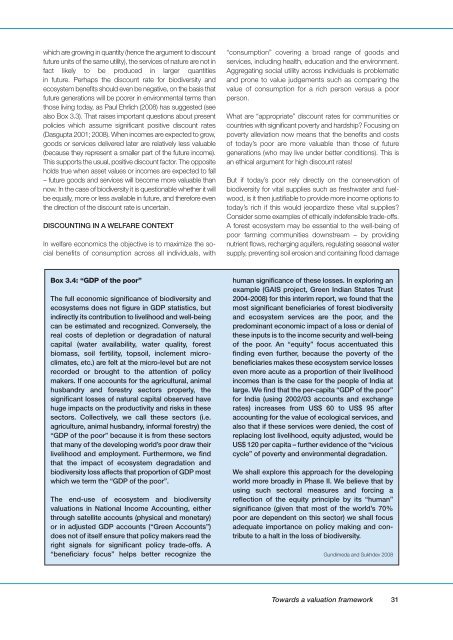Interim Report - TEEB
Interim Report - TEEB
Interim Report - TEEB
Create successful ePaper yourself
Turn your PDF publications into a flip-book with our unique Google optimized e-Paper software.
which are growing in quantity (hence the argument to discount<br />
future units of the same utility), the services of nature are not in<br />
fact likely to be produced in larger quantities<br />
in future. Perhaps the discount rate for biodiversity and<br />
ecosystem benefits should even be negative, on the basis that<br />
future generations will be poorer in environmental terms than<br />
those living today, as Paul Ehrlich (2008) has suggested (see<br />
also Box 3.3). That raises important questions about present<br />
policies which assume significant positive discount rates<br />
(Dasgupta 2001; 2008). When incomes are expected to grow,<br />
goods or services delivered later are relatively less valuable<br />
(because they represent a smaller part of the future income).<br />
This supports the usual, positive discount factor. The opposite<br />
holds true when asset values or incomes are expected to fall<br />
– future goods and services will become more valuable than<br />
now. In the case of biodiversity it is questionable whether it will<br />
be equally, more or less available in future, and therefore even<br />
the direction of the discount rate is uncertain.<br />
DISCOUNTING IN A WELFARE CONTEXT<br />
In welfare economics the objective is to maximize the social<br />
benefits of consumption across all individuals, with<br />
“consumption” covering a broad range of goods and<br />
services, including health, education and the environment.<br />
Aggregating social utility across individuals is problematic<br />
and prone to value judgements such as comparing the<br />
value of consumption for a rich person versus a poor<br />
person.<br />
What are “appropriate” discount rates for communities or<br />
countries with significant poverty and hardship? Focusing on<br />
poverty alleviation now means that the benefits and costs<br />
of today’s poor are more valuable than those of future<br />
generations (who may live under better conditions). This is<br />
an ethical argument for high discount rates!<br />
But if today’s poor rely directly on the conservation of<br />
biodiversity for vital supplies such as freshwater and fuelwood,<br />
is it then justifiable to provide more income options to<br />
today’s rich if this would jeopardize these vital supplies?<br />
Consider some examples of ethically indefensible trade-offs.<br />
A forest ecosystem may be essential to the well-being of<br />
poor farming communities downstream – by providing<br />
nutrient flows, recharging aquifers, regulating seasonal water<br />
supply, preventing soil erosion and containing flood damage<br />
Box 3.4: “GDP of the poor”<br />
The full economic significance of biodiversity and<br />
ecosystems does not figure in GDP statistics, but<br />
indirectly its contribution to livelihood and well-being<br />
can be estimated and recognized. Conversely, the<br />
real costs of depletion or degradation of natural<br />
capital (water availability, water quality, forest<br />
biomass, soil fertility, topsoil, inclement microclimates,<br />
etc.) are felt at the micro-level but are not<br />
recorded or brought to the attention of policy<br />
makers. If one accounts for the agricultural, animal<br />
husbandry and forestry sectors properly, the<br />
significant losses of natural capital observed have<br />
huge impacts on the productivity and risks in these<br />
sectors. Collectively, we call these sectors (i.e.<br />
agriculture, animal husbandry, informal forestry) the<br />
“GDP of the poor” because it is from these sectors<br />
that many of the developing world’s poor draw their<br />
livelihood and employment. Furthermore, we find<br />
that the impact of ecosystem degradation and<br />
biodiversity loss affects that proportion of GDP most<br />
which we term the “GDP of the poor”.<br />
The end-use of ecosystem and biodiversity<br />
valuations in National Income Accounting, either<br />
through satellite accounts (physical and monetary)<br />
or in adjusted GDP accounts (“Green Accounts”)<br />
does not of itself ensure that policy makers read the<br />
right signals for significant policy trade-offs. A<br />
“beneficiary focus” helps better recognize the<br />
human significance of these losses. In exploring an<br />
example (GAIS project, Green Indian States Trust<br />
2004-2008) for this interim report, we found that the<br />
most significant beneficiaries of forest biodiversity<br />
and ecosystem services are the poor, and the<br />
predominant economic impact of a loss or denial of<br />
these inputs is to the income security and well-being<br />
of the poor. An “equity” focus accentuated this<br />
finding even further, because the poverty of the<br />
beneficiaries makes these ecosystem service losses<br />
even more acute as a proportion of their livelihood<br />
incomes than is the case for the people of India at<br />
large. We find that the per-capita “GDP of the poor”<br />
for India (using 2002/03 accounts and exchange<br />
rates) increases from US$ 60 to US$ 95 after<br />
accounting for the value of ecological services, and<br />
also that if these services were denied, the cost of<br />
replacing lost livelihood, equity adjusted, would be<br />
US$ 120 per capita – further evidence of the “vicious<br />
cycle” of poverty and environmental degradation.<br />
We shall explore this approach for the developing<br />
world more broadly in Phase II. We believe that by<br />
using such sectoral measures and forcing a<br />
reflection of the equity principle by its “human”<br />
significance (given that most of the world’s 70%<br />
poor are dependent on this sector) we shall focus<br />
adequate importance on policy making and contribute<br />
to a halt in the loss of biodiversity.<br />
Gundimeda and Sukhdev 2008<br />
Towards a valuation framework<br />
31

















